Are you frustrated by the lack of fruit on your plum tree? I understand how disappointing it can be, but don’t worry, I’m here to help. In this article, I will provide you with valuable insights and tips to understand why your plum tree might not be producing any fruit and how you can increase its fruit yield. Let’s delve into the possible reasons and find solutions together.
Key Takeaways:
- Plum trees may fail to bear fruit due to various reasons
- Lack of proper pollination and suitable pollination partners can hinder fruit production
- Environmental factors, such as frost damage and improper timing, can affect fruiting
- Nutrient deficiencies, like insufficient nitrogen or potassium, can hinder fruit production
- Proper pruning and training techniques can promote fruiting while poor techniques may hinder it
Reasons for No Fruit on Plum Trees
Plum trees can be a delightful addition to any garden, providing beautiful blossoms and a bountiful harvest of delicious fruits. However, it can be deeply disappointing when your plum tree fails to produce any fruit. There can be several reasons behind this frustrating issue, including lack of flowering, failure to set fruit, and various other fruiting issues. Understanding these reasons is essential in order to address the problem effectively and restore fruit production to your plum tree.
Let’s dive deeper into each of these potential causes:
Lack of Flowering
Flowering is the first step in the fruit production process for plum trees. Without proper flowering, there will be no fruits. There are several factors that can inhibit or prevent flowering, such as:
- Insufficient chilling hours: Some plum tree varieties require a specific amount of cold weather in order to trigger flowering. If your plum tree hasn’t received enough chilling hours, it may not produce flowers.
- Pruning at the wrong time: Improper pruning techniques or pruning at the wrong time of the year can disrupt the tree’s natural flowering cycle.
- Stress or poor health: Plum trees that are stressed or in poor health may not have the energy to produce flowers.
Failure to Set Fruit
Even if your plum tree has successfully flowered, it doesn’t guarantee fruit set. Fruit set occurs when the flowers are pollinated and the fertilized ovaries develop into fruits. Several factors can contribute to the failure of fruit set, including:
- Poor pollination: Plum trees may have low pollination rates if there are not enough pollinators (such as bees) in the area, or if the weather conditions during bloom were unfavorable for pollination.
- Lack of compatible pollination partners: Some plum tree varieties require cross-pollination with a different variety to set fruit. If your plum tree doesn’t have a suitable partner nearby, it may not set fruit.
- Environmental stress: Extreme weather conditions, such as high temperatures or water stress, can interfere with successful fruit set.
Fruiting Issues
Once fruit set has occurred, there can still be hurdles in the fruiting process that prevent the development of ripe, healthy fruits. Some common fruiting issues that can affect plum trees include:
- Pest and disease infestations: Plum trees can be attacked by various pests and diseases that damage the fruits or cause them to drop prematurely.
- Nutrient deficiencies or imbalances: Lack of essential nutrients, such as nitrogen, phosphorus, or potassium, can compromise fruit development and quality.
- Improper pruning or training: Incorrect pruning practices, such as over-pruning or poor training, can disrupt the tree’s growth and fruiting patterns.
Identifying the specific issue affecting your plum tree is crucial in developing an appropriate solution. Observing the tree’s growth patterns, assessing its overall health, and addressing any environmental or care-related issues will help you restore fruit production and enjoy a bountiful plum harvest.
Lack of Proper Pollination
One of the main reasons why plum trees may not bear fruit is a lack of proper pollination. Pollination is essential for the fertilization of flowers, which leads to the formation of fruit. While some plum tree varieties are self-pollinating, meaning they can set fruit on their own, many others require a suitable pollination partner of a different variety to produce fruit.
If your plum tree is not producing fruit, it could be due to the absence of a compatible pollination partner or ineffective pollination. Without the presence of pollinators or the transfer of pollen between the flowers, fruit development may not occur.
To ensure proper pollination and increase the chances of fruit production, it is important to choose plum tree varieties that are known to be good pollination partners. These varieties should flower around the same time and have compatible pollen. By planting compatible pollination partners nearby, you can enhance the chances of successful pollination and fruit set.
“Proper pollination is crucial for plum tree fruit production. Without a suitable pollination partner, fruit development may be hindered.”
Self-Pollinating Plum Trees
Some plum tree varieties are self-pollinating, which means they are capable of setting fruit without the need for cross-pollination. These trees have both male and female reproductive organs within the same flower, allowing them to self-fertilize. Self-pollinating plum trees are a great option for those with limited garden space or without access to compatible pollination partners.
Examples of self-pollinating plum tree varieties include:
- Italian Prune
- Methley
- Satsuma
If you have a self-pollinating plum tree and it is not setting fruit, there may be other factors at play, such as inadequate pollinator activity or poor environmental conditions.
Choosing Pollination Partners
If your plum tree requires a pollination partner, it is important to choose the right variety to ensure successful cross-pollination. Consider the following factors when selecting a pollination partner:
- Choose a variety that flowers around the same time as your plum tree to maximize the overlap of flowering periods.
- Ensure that the chosen variety has compatible pollen by checking with your local nursery or an experienced gardener.
- Plant the pollination partner in close proximity to your plum tree for efficient pollination.
By understanding the pollination requirements of your plum tree and selecting suitable pollination partners, you can significantly improve fruit set and increase the chances of a bountiful harvest.
Remember, providing the right conditions for pollination is just one aspect of ensuring fruit production in plum trees. It is essential to address other factors like environmental conditions, pruning, and tree health to optimize fruit yield.
Environmental Factors
When it comes to fruit production in plum trees, environmental factors play a crucial role. Understanding and managing these factors can help ensure a bountiful harvest. Let’s explore some of the key environmental factors that can impact plum tree fruit production.
Plum Tree Frost Damage
One of the most significant challenges plum trees face is frost damage. Early or late frost can harm the delicate blossoms, preventing fruit from forming. To protect your plum tree from frost damage, it’s important to take proactive measures. Check the local weather forecasts and cover your tree with frost blankets or burlap if frost is expected. This will help shield the blossoms and ensure they can develop into healthy fruit.
Plum Tree Flowering and Fruiting Time
Plum trees have specific timing requirements for flowering and fruiting. Deviations from these ideal conditions can affect fruit production. It’s important to understand the optimal flowering and fruiting time for your specific plum tree variety. This will allow you to provide the right care and attention during these critical periods. Consulting with a local horticulturist or agricultural extension office can help you determine the ideal timings for your region and specific plum tree variety.
Plum Tree Winter Care
Winter care is essential for the overall health and fruit production of plum trees. Freezing temperatures can damage the tree and impact fruiting. To protect your plum tree during winter, consider the following tips:
- Apply a layer of organic mulch around the base of the tree to insulate the roots and protect them from freezing temperatures.
- Water your plum tree adequately before the ground freezes to ensure it enters the dormant stage in a well-hydrated state.
- Avoid excessive pruning during winter, as it can stimulate new growth that may be susceptible to frost damage.
By providing proper winter care, you can help mitigate the impact of environmental factors and set the stage for a successful fruiting season.
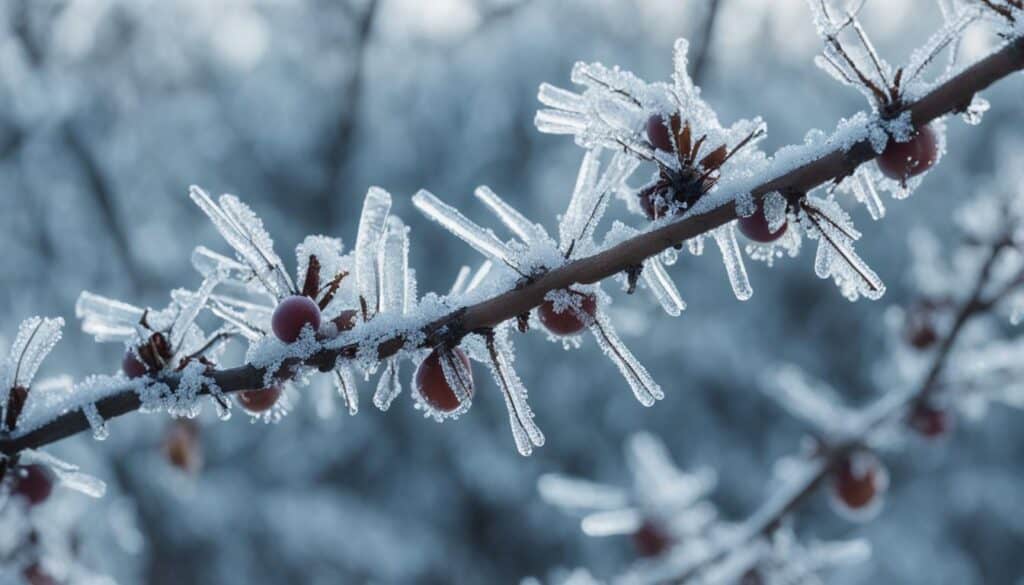
| Environmental Factor | Impact on Plum Tree Fruit Production |
|---|---|
| Frost damage | Prevents fruit from forming by damaging blossoms |
| Incorrect flowering and fruiting timing | Affects fruit development and production |
| Winter care | Protects the tree from freezing temperatures and ensures healthy fruiting |
Nutrient Deficiencies
To ensure healthy fruit production, plum trees require specific nutrients. Insufficient levels of essential nutrients like nitrogen, phosphorus, or potassium can hinder fruiting. To optimize fruit yield, it is crucial to understand the nutrient requirements of plum trees and provide appropriate fertilization.
Plum trees rely on a balanced supply of nutrients to develop and produce high-quality fruit. The lack of nutrients can lead to underdeveloped or stunted fruit, affecting both the quantity and quality of the harvest.
Nutrient Requirements of Plum Trees
Plum trees have specific nutrient needs that must be met for optimal fruit production:
- Nitrogen (N): Nitrogen is essential for overall tree growth and development. It plays a vital role in leaf and shoot growth, as well as the formation of flower buds.
- Phosphorus (P): Phosphorus helps with root development, promoting strong and healthy plum tree growth. It also supports flower formation and enhances fruit development.
- Potassium (K): Potassium is crucial for the overall vigor and health of plum trees. It aids in water utilization and plays a role in improving fruit quality and taste.
By understanding the specific nutrient requirements of plum trees, you can tailor your fertilization approach to address any deficiencies and promote abundant fruiting.
Fertilization for Optimal Fruit Yield
Applying fertilizer at the right time and using the correct formulation is essential for meeting the nutrient requirements of plum trees. Here are some key points to consider when fertilizing your plum tree:
- Soil Testing: Conduct a soil test to determine the existing nutrient levels and identify any deficiencies. This will help you create a targeted fertilization plan.
- Timing: Apply fertilizers at the appropriate time to ensure optimal nutrient uptake by the tree. Early spring, before bud break, and late fall, after leaf drop, are generally recommended.
- Balanced Formulation: Choose a balanced fertilizer formulation that provides equal proportions of nitrogen (N), phosphorus (P), and potassium (K). Read the label carefully to select the right fertilizer for your plum tree’s specific nutrient needs.
- Application Method: Apply fertilizers evenly around the dripline of the tree, avoiding direct contact with the trunk. Incorporate the fertilizer into the soil surface and water thoroughly to aid in nutrient absorption.
- Frequency: For established plum trees, yearly fertilization is usually sufficient. However, the specific fertilizer requirements may vary depending on the soil conditions and the tree’s overall health.
Remember to follow the manufacturer’s instructions and recommendations for proper fertilizer application. Over-fertilization can be just as harmful as under-fertilization, so it’s essential to strike the right balance.
| Common Nutrient Deficiencies in Plum Trees | Visual Symptoms |
|---|---|
| Nitrogen (N) Deficiency | Yellowing of leaves (chlorosis), stunted growth, reduced fruit size |
| Phosphorus (P) Deficiency | Purple or reddish discoloration on leaves, stunted growth, delayed fruiting |
| Potassium (K) Deficiency | Yellowing and browning of leaf margins, weak branches, low fruit quality |
Consulting with a local horticulturist or extension service can provide valuable insights tailored to your specific region and plum tree variety. They can help you diagnose nutrient deficiencies, recommend appropriate fertilizers, and guide you in developing an effective fertilization plan.
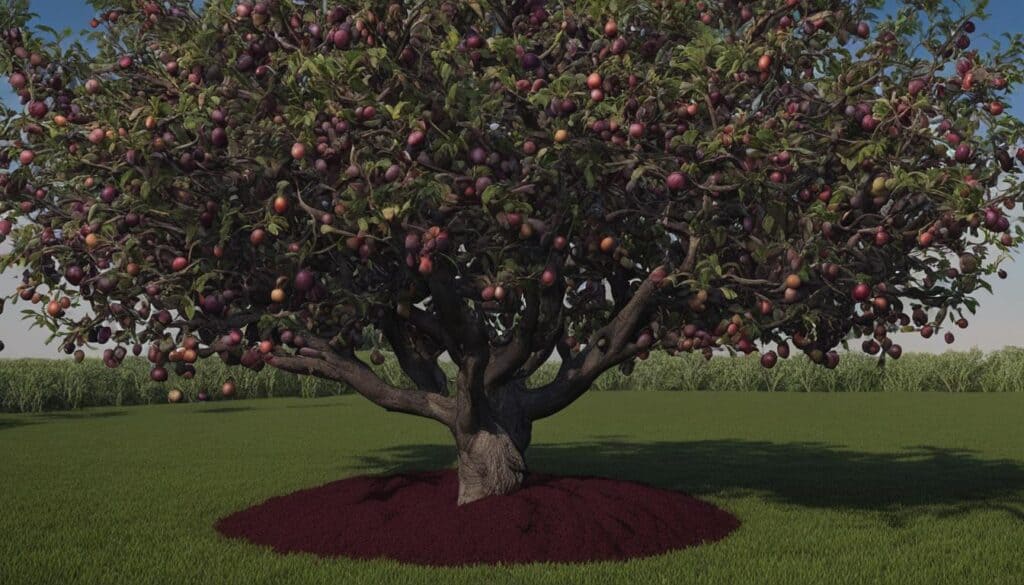
Pruning and Training
Proper pruning and training techniques are essential for promoting fruit production in plum trees. Incorrect or excessive pruning practices can negatively impact fruiting, while employing the right techniques can stimulate fruit production and improve the overall health of the tree.
When it comes to plum tree pruning, it’s crucial to follow a few guidelines. First, prune during the dormant season, preferably in late winter or early spring before the trees start to bud. This allows you to see the tree’s structure clearly and make accurate pruning decisions.
Start by removing any dead or diseased branches, as they can inhibit the tree’s ability to produce fruit. Also, eliminate any branches that are crossing or rubbing against each other, as they can lead to damage and disease. Thinning out some of the interior branches can improve air circulation and light penetration, benefiting fruit production.
However, it’s important not to over-prune plum trees. Removing too many branches can result in reduced fruiting, as the tree needs a sufficient number of branches to support fruit production. Additionally, excessive pruning can cause stress to the tree, leading to poor growth and increased susceptibility to diseases.
Training also plays a significant role in achieving optimal fruit production. The purpose of training is to shape the tree’s structure, ensuring its branches are well-distributed and able to bear the weight of fruit. It’s important to train plum trees early on, ideally in their first couple of years, to establish the desired shape and structure.
One popular training method for plum trees is the central leader system. This approach involves selecting a central, upright branch as the tree’s leader and removing competing branches to maintain a dominant central leader. The central leader system helps create a well-balanced tree structure and encourages the development of fruit-bearing lateral branches.
Another training technique for plum trees is espalier, where the branches are trained flat against a wall or trellis. Espalier allows for better light exposure, improved air circulation, and increased production in limited space. However, this method requires careful pruning and training to ensure the branches remain in the desired position.
By understanding the importance of proper pruning and training techniques, you can take proactive steps to enhance fruit production in your plum trees. Remember to prune during the correct season, remove dead or diseased branches, thin out the interior for better airflow, and avoid over-pruning. Additionally, consider training your plum tree using methods like the central leader system or espalier to create a well-structured and productive tree.
Tree Age and Health
Plum trees, like any living organism, have a natural lifespan. As these trees age, their ability to produce fruit may gradually decline. This decline in fruit production is a natural process that occurs as the tree goes through its life cycle.
Additionally, as plum trees age, they become more vulnerable to diseases and pests, which can further impact their fruiting. Diseases such as plum pox virus and pests like plum curculio can cause significant damage to the tree and hinder fruit production.
Understanding the age and health of your plum tree is essential in managing your expectations and taking appropriate care measures to maintain or improve fruit production. Regularly inspecting your tree for signs of disease or pests and promptly addressing any issues can help preserve the health of your plum tree.
Proper tree care, including regular pruning, fertilization, and adequate watering, can also contribute to the overall health and vitality of the tree, ultimately supporting its fruiting capabilities.
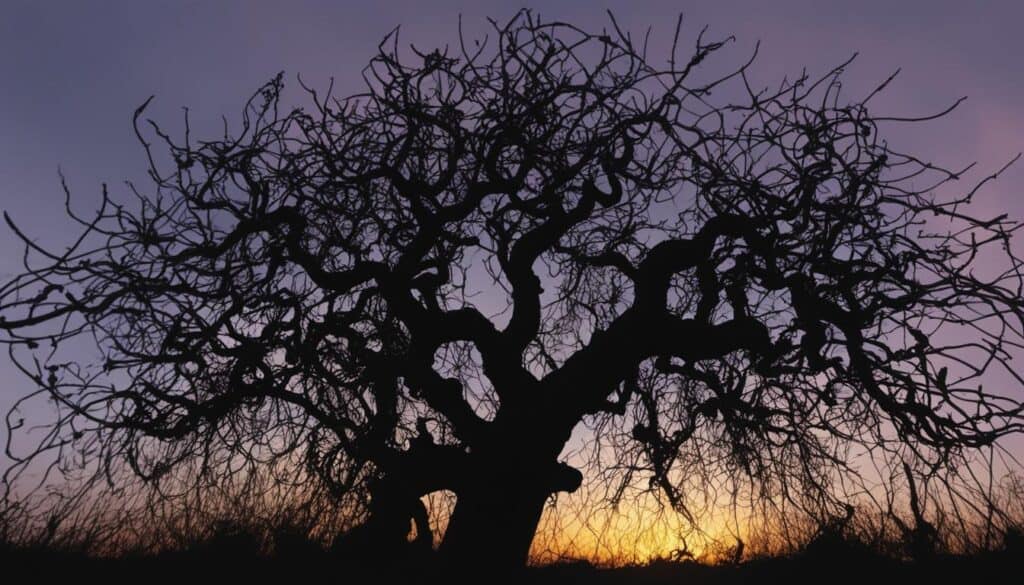
Comparison of Plum Tree Lifespans
| Plum Tree Variety | Average Lifespan |
|---|---|
| European Plum | 15-30 years |
| Japanese Plum | 15-30 years |
| Cherry Plum | 10-20 years |
Table: Comparison of Plum Tree Lifespans
While individual plum tree lifespans may vary depending on various factors such as cultivar, growing conditions, and overall tree health, this table provides a general overview of the average lifespans for different plum tree varieties.
It is important to note that some plum trees can live longer than the ranges mentioned in the table, especially with proper care and maintenance. Regularly monitoring the health and fruit production of your plum tree can help you determine the appropriate steps to take to support its longevity and fruiting potential.
Watering and Irrigation
Proper watering and irrigation are crucial for ensuring the health and fruit production of your plum trees. Lack of water or inconsistent watering can have a detrimental effect on the fruiting process, leading to poor fruiting or no fruit at all. To optimize fruit production, it is important to understand the water requirements of plum trees and implement effective irrigation practices.
Plum tree water requirements may vary depending on factors such as climate, soil type, and tree age. Generally, plum trees require regular deep watering, especially during periods of active growth and fruit development. Deep watering promotes healthy root growth and helps the tree access water stored deeper in the soil.
During the early stages of fruit development, it is essential to ensure adequate moisture to support proper fruit formation. A consistent water supply during this critical period can prevent fruit drop and enhance the overall fruit quality.
Proper Irrigation Techniques
Implementing proper irrigation techniques is crucial for optimizing fruit production on plum trees. Here are some key tips:
- Water deeply: Apply water slowly and deeply to penetrate the root zone. This encourages the development of a strong root system.
- Use mulch: Apply a layer of organic mulch around the base of the tree to help retain soil moisture and minimize weed growth.
- Monitor soil moisture: Regularly check the moisture level in the soil to ensure it remains consistently moist but not waterlogged.
- Consider drip irrigation: Drip irrigation systems deliver water directly to the tree’s root zone, reducing water waste and promoting efficient water uptake.
Irrigating plum trees properly is essential for optimizing fruit production. Proper watering techniques, such as deep watering and monitoring soil moisture, can ensure that your plum tree receives adequate moisture for healthy growth and optimal fruiting.
Remember that while water is crucial, overwatering can be just as harmful as underwatering. Avoid creating waterlogged conditions that can lead to root rot or other diseases.
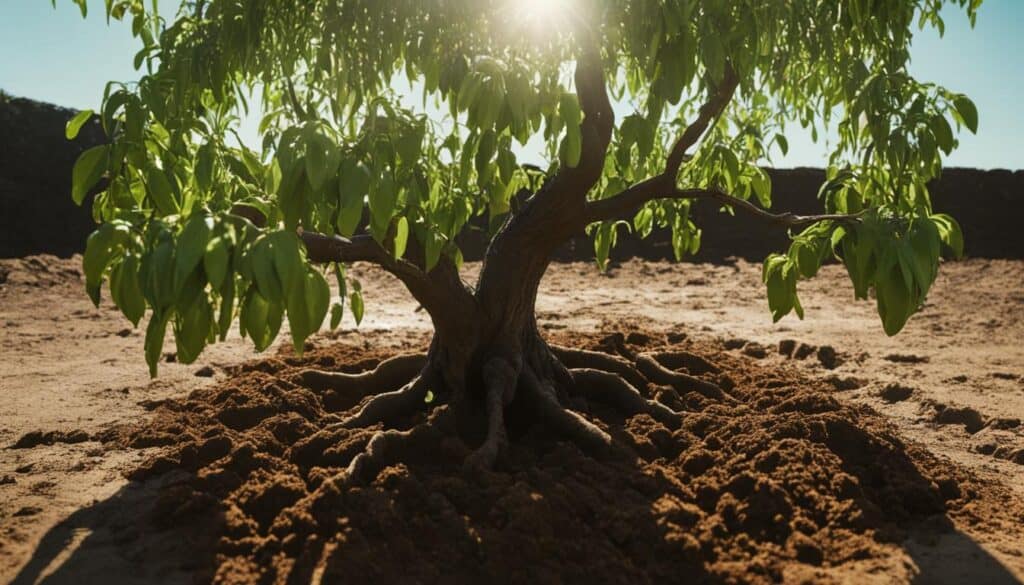
By understanding the water needs of your plum trees and implementing proper irrigation practices, you can provide the ideal growing conditions for optimal fruit production. Consistent and appropriate watering will help your plum tree thrive and yield a bountiful harvest.
Conclusion
So, if you’re frustrated by your plum tree’s lack of fruit, don’t worry! There are several strategies you can implement to boost fruit production and enjoy a bountiful harvest.
First, make sure your plum tree has a suitable pollination partner. Some plum trees are self-pollinating, but most require a different variety for effective pollination. By ensuring proper pollination, you increase the chances of your plum tree setting fruit.
Next, pay attention to environmental factors that may impact fruit production. Protect your plum tree from early or late frosts, which can damage the blossoms and prevent fruit formation. Additionally, be mindful of the specific timing requirements for flowering and fruiting of your plum tree. Providing proper winter care and creating ideal growing conditions will help maximize fruit yield.
Moreover, remember to address nutrient deficiencies by understanding the specific nutrient requirements of your plum tree. Fertilize accordingly to ensure optimal growth and fruit production. Additionally, practice correct pruning techniques to stimulate fruiting and maintain tree health.
Lastly, consider the age and health of your plum tree. Older trees may naturally produce less fruit, while disease or pest infestations can further hinder fruiting. Knowing the condition of your tree will help you manage your expectations and take appropriate measures to support its fruit production.
By implementing these tips and strategies – proper pollination, addressing environmental factors, ensuring nutrient availability, practicing correct pruning techniques, and considering tree age and health – you can increase fruit production on your plum tree and have a flourishing harvest for years to come!
FAQ
Why isn’t my plum tree bearing fruit?
There can be several reasons why plum trees fail to produce fruit, including lack of pollination, environmental factors, nutrient deficiencies, improper pruning, tree age, and watering issues. Understanding these factors can help you identify and address the specific issue with your plum tree.
Does my plum tree need a pollination partner?
Some plum tree varieties are self-pollinating and can set fruit on their own. However, many plum trees require a pollination partner of a different variety to produce fruit. If your plum tree is not producing fruit, it may be because it lacks a suitable pollination partner or is not being effectively pollinated.
How do environmental factors affect plum tree fruit production?
Environmental factors such as frost damage, improper timing of flowering and fruiting, and lack of winter care can impact plum tree fruit production. Early or late frost can damage the blossoms and prevent fruit from forming. Providing proper winter care, such as protection from freezing temperatures and adequate mulching, can help mitigate the impact of environmental factors.
What nutrient deficiencies can affect plum tree fruit production?
Plum trees require certain nutrients, such as nitrogen, phosphorus, and potassium, to produce healthy fruit. Insufficient levels of these nutrients can hinder fruit production. Understanding the specific nutrient requirements of plum trees and providing appropriate fertilization can help ensure optimal fruit yield.
How does pruning affect plum tree fruit production?
Proper pruning and training techniques can stimulate fruiting and improve overall tree health. However, improper pruning practices, such as excessive or incorrect pruning, can negatively affect fruiting. Learning the right way to prune and train your plum tree is essential for maximizing fruit production.
Can the age and health of my plum tree affect fruit production?
Plum trees have a lifespan, and as they age, their fruit production may decline. Older trees may also become more susceptible to diseases or pests, which can further affect fruiting. Understanding the age and health of your plum tree can help you manage expectations and take appropriate care measures to maintain or improve fruit production.
How does watering impact plum tree fruit production?
Adequate watering is essential for the health and fruit production of plum trees. Insufficient or inconsistent water supply can lead to poor fruiting or no fruit at all. Understanding the water requirements of plum trees and implementing proper irrigation practices is crucial for optimizing fruit production.
How can I increase fruit production on my plum tree?
To increase fruit production on your plum tree, you can take several steps, including ensuring proper pollination, addressing environmental factors, providing adequate nutrients, practicing correct pruning techniques, considering the age and health of your tree, and implementing proper watering and irrigation practices. By addressing these factors, you can optimize fruit production and enjoy a bountiful harvest.

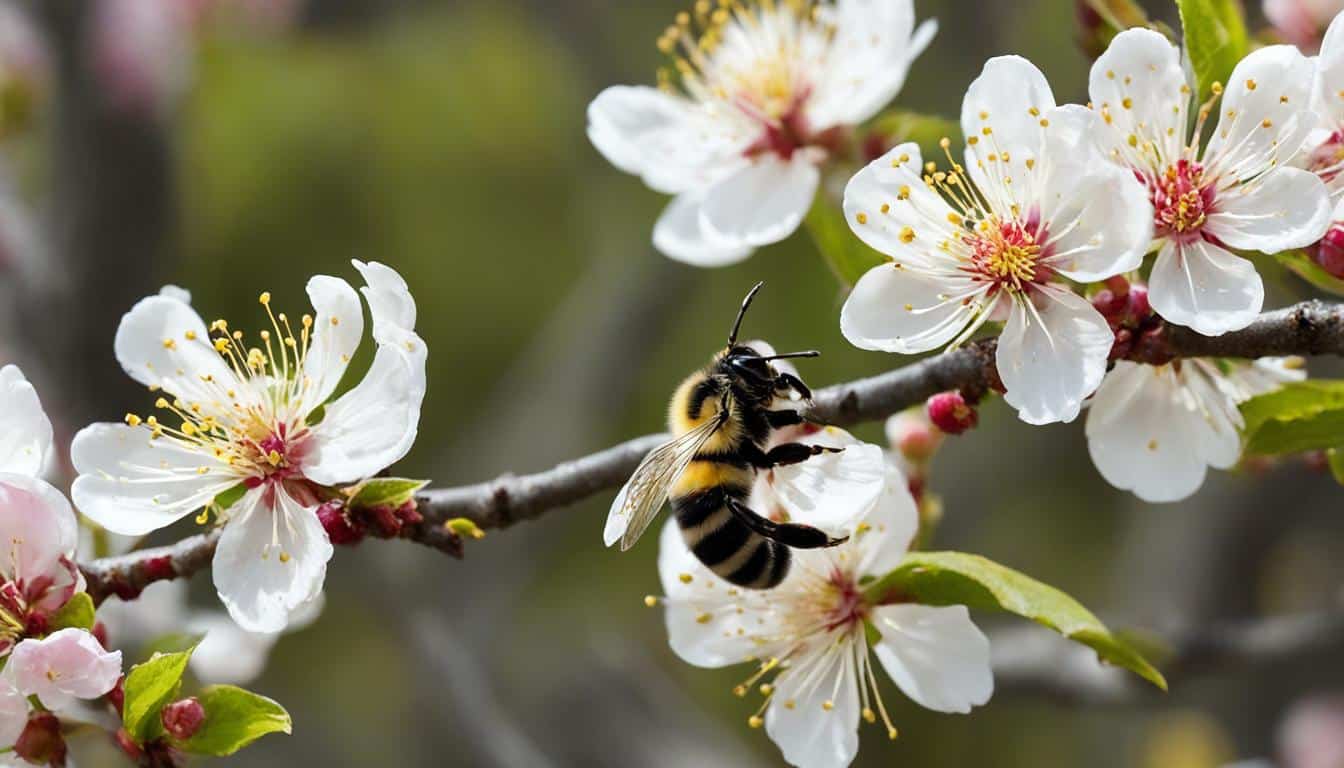



Leave a Reply